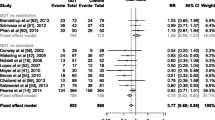Abstract
Purpose
Maintenance fluids following major operations in children are typically administered with a continuous rate. We hypothesized that administering fluids as intermittent boluses is more physiologic and could limit post-operative fluid volume, thereby avoiding harmful effects of excess fluid.
Methods
We retrospectively reviewed children aged 1–21 admitted after an elective major abdominal or thoracic operation from 2015 to 2021. We excluded non-elective operations and patients receiving peri-operative enteral or parenteral nutrition. We analyzed total fluid volume at 0–24, 24–48, 48–72, and 72–96 h, time to regular diet and discharge, and end-organ complications.
Results
We identified 363 patients, of which 108 received intermittent boluses and 255 continuous fluids. Bolus group patients received significantly less fluid up to 72 h post-operatively with average rates of 0.49 mL/kg/h vs 0.86 mL/kg/h at 0–24 h (p << 0.01), 0.57 mL/kg/h vs 1.46 mL/kg/h at 24–48 h (p << 0.01), and 0.50 vs 0.92 mL/kg/h at 48–72 h (p << 0.01). Additionally, the bolus group maintained adequate urine output, tolerated a regular diet sooner (2.08 days vs 2.51 days; p = 0.0023) and averaged a shorter hospital stay (3.12 vs 4.14 days; p = 0.004). There was no difference in adverse effects between the two groups.
Conclusion
Utilizing intermittent boluses reduces the volume of maintenance fluids administered and may lead to a faster time to regular diet and discharge.
Level of evidence
IV.
Type of study
Retrospective review.



Similar content being viewed by others
References
Holliday MA, Segar WE (1957) The maintenance need for water in parenteral fluid therapy. Pediatrics 19:823–832
Way C, Dhamrait R, Wade A et al (2006) Perioperative fluid therapy in children: a survey of current prescribing practice. Br J Anaesth 97:371–379
Alves JT, Troster EJ, Oliveira CA (2011) Isotonic saline solution as maintenance intravenous fluid therapy to prevent acquired hyponatremia in hospitalized children. J Pediatr 87:478–486
Sümpelmann R, Becke K, Zander R et al (2019) Perioperative fluid management in children: can we sum it all up now? Curr Opin Anaesthesiol 32:384–391
Sümpelmann R, Becke K, Crean P et al (2011) European consensus statement for intraoperative fluid therapy in children. Eur J Anaesthesiol 28:637–639
Yunos NM, Bellomo R, Hegarty C et al (2012) Association between a chloride-liberal vs chloride-restrictive intravenous fluid administration strategy and kidney injury in critically ill adults. JAMA 308:1566–1572
Myburgh JA, Mythen MG (2013) Resuscitation fluids. N Engl J Med 369:1243–1251
Malbrain M, Langer T, Annane D et al (2020) Intravenous fluid therapy in the perioperative and critical care setting: executive summary of the International Fluid Academy (IFA). Ann Intensive Care 10:64
Sumpelmann R, Becke K, Brenner S et al (2017) Perioperative intravenous fluid therapy in children: guidelines from the Association of the Scientific Medical Societies in Germany. Paediatr Anaesth 27:10–18
Arieff AI (1998) Postoperative hyponatraemic encephalopathy following elective surgery in children. Paediatr Anaesth 8:1–4
Ayus JC, Achinger SG, Arieff A (2008) Brain cell volume regulation in hyponatremia: role of sex, age, vasopressin, and hypoxia. Am J Physiol Renal Physiol 295:619–624
Nishina K, Mikawa K, Maekawa N et al (1995) Effects of exogenous intravenous glucose on plasma glucose and lipid homeostasis in anesthetized infants. Anesthesiology 83:258–263
Self WH, Semler MW, Wanderer JP et al (2018) Balanced crystalloids versus saline in noncritically ill adults. N Engl J Med 378:819–828
Berleur MP, Dahan A, Murat I et al (2003) Perioperative infusions in paediatric patients: rationale for using Ringer-lactate solution with low dextrose concentration. J Clin Pharm Ther 28:31–40
Sumpelmann R, Mader T, Eich C et al (2010) A novel isotonic-balanced electrolyte solution with 1% glucose for intraoperative fluid therapy in children: results of a prospective multicentre observational postauthorization safety study (PASS). Paediatr Anaesth 20:977–981
Shan SK, Uray KS, Stewart RH et al (2011) Resuscitation-induced intestinal edema and related dysfunction: state of the science. J Surg Res 166:120–130
Radhakrishnan RS, Xue H, Weisbrodt N et al (2005) Resuscitation-induced intestinal edema decreases stiffness and residual stress of the intestine. Shock 24:165–170
Cordemans C, De Laet I, Regenmortel NV et al (2012) Fluid management in critically ill patients: the role of extravascular lung water, abdominal hypertension, capillary leak, and fluid balance. Ann Intensive Care 5:2–12
Boyd JH, Forbes J, Nakada TA et al (2011) Fluid resuscitation in septic shock: a positive fluid balance and elevated central venous pressure are associated with increased mortality. Crit Care Med 39:259–265
The National Heart, Lung, and Blood Institute Acute Respiratory Distress Syndrome (ARDS) Clinical Trials Network (2006) Comparison of two fluid-management strategies in acute lung injury. N Engl J Med 354:2564–2575
Saringcarinkul A, Kotrawera K (2009) Plasma glucose level in elective surgical patients administered with 5% dextrose in 0.45% NaCl in comparison with those receiving lactated ringer’s solution. J Med Assoc Thai 92:1178–1183
Rajan S, Barua K, Tosh P et al (2020) Is intraoperative supplementation of dextrose essential for infants undergoing facial cleft surgeries? J Anaesthesiol Clin Pharmacol 36:162–165
Adenekan AT (2014) Perioperative blood glucose in a paediatric daycase facility: effects of fasting and maintenance fluid. Afr J Paediatr Surg 11:317–322
Acknowledgements
This research did not receive any specific grant from funding agencies in the public, commercial, or not-for-profit sectors.
Author information
Authors and Affiliations
Corresponding author
Ethics declarations
Conflict of interest
Statement of competing interests: the authors have no competing interests to declare. No financial support has been provided for this research.
Additional information
Publisher's Note
Springer Nature remains neutral with regard to jurisdictional claims in published maps and institutional affiliations.
Rights and permissions
About this article
Cite this article
Johnston, W.R., Hwang, R. & Mattei, P. Intermittent boluses of balanced salt solution for post-operative intravenous hydration following elective major abdominal and thoracic surgery in children. Pediatr Surg Int 38, 573–579 (2022). https://doi.org/10.1007/s00383-022-05081-7
Accepted:
Published:
Issue Date:
DOI: https://doi.org/10.1007/s00383-022-05081-7




